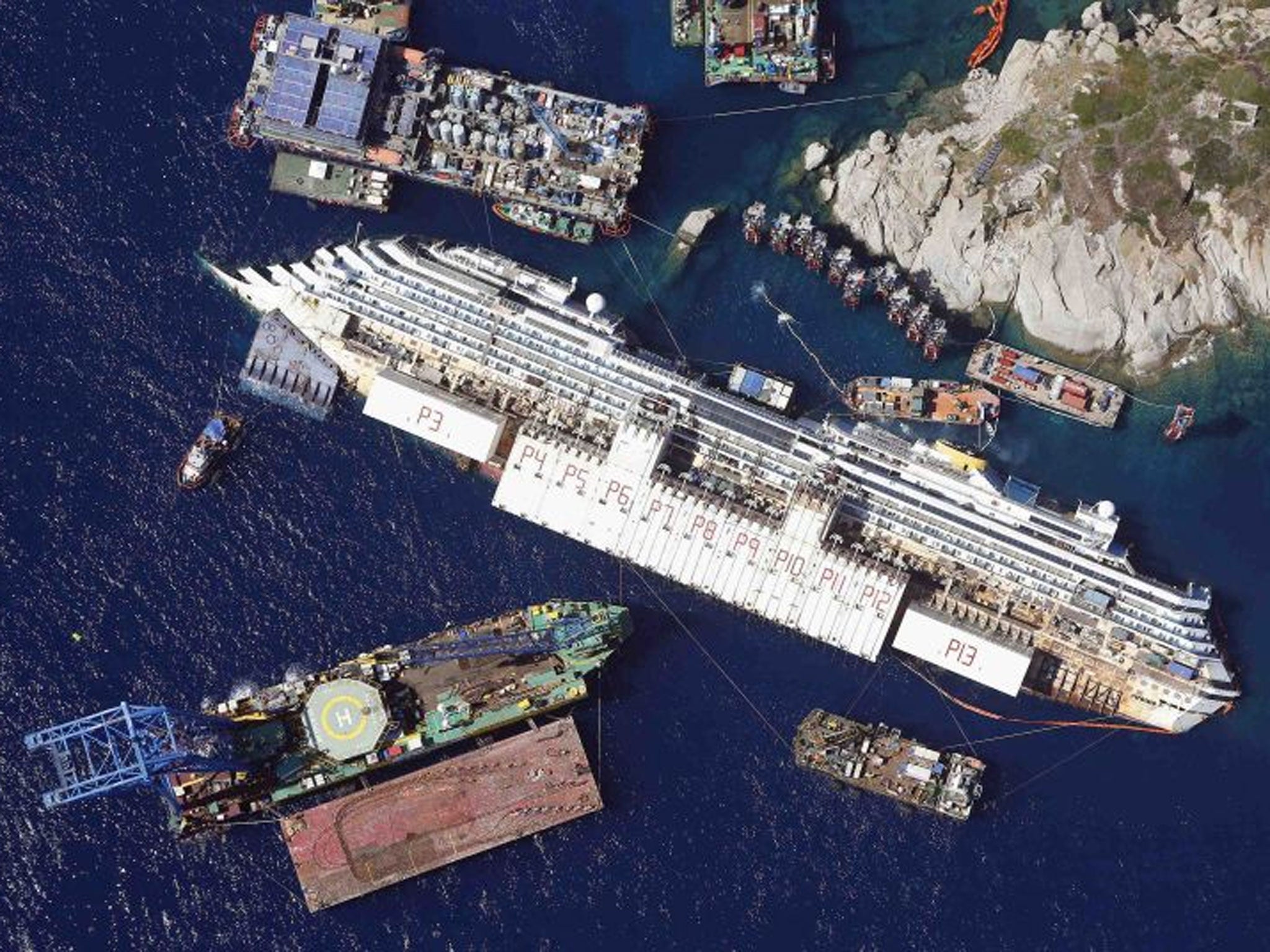Costa Concordia: Italy prepares to salvage a maritime disaster
The fraught international operation to right the capsized ‘Costa Concordia’ begins tomorrow, and tensions are high

What happens when you roll a giant cruise liner, the length of three football pitches, into the upright position after it has been left to rust in the sea for 20 months? This is the €600m (£500m) question that engineers are due to answer at daybreak tomorrow, just outside the little port of Giglio.
The partially capsized Costa Concordia, which crashed into rocks off the Tuscan island in January 2012 with the loss of 32 lives, will be dragged erect with cords – or parbuckled – to rest on a specially built underwater platform, before buoyancy devices are attached and it is towed away for scrap at a mainland port in the spring.
If the strategy seems straightforward, the operation is, in reality, fraught with danger.
Franco Porcellacchia, the director of technical operations at Concordia’s owner, Costa Cruises, spelt it out: “It’s an extraordinary operation, not because parbuckling has never been done before, but because it’s never done with such a big ship.”
Costa Cruises has stumped up the €600m bill thus far. But the work has been done by the US company Titan Salvage and Italian marine contractor Micoperi. Both firms agree the plan is “unprecedented”.
Of particular concern is the condition of the starboard side of the 114,500-gross tonnage vessel. The salvagers cannot guarantee that it will withstand the huge stresses when the vessel is pulled upright. Equally worrying are the possible consequences should the vessel disintegrate during the parbuckling process.
Inside, the giant vessel is awash with sewage, detergents and other chemicals. A report by Costa Cruises said that the wreck will contain “organic substances, which might be transformed by microbial degradation into hydrogen sulphide, plus heavy metals and hydrocarbons”. The threat of this toxic brew spilling into an area regarded as a pristine nature reserve with high biodiversity, is the stuff of nightmares for environmentalists and for locals who rely on the tourist trade.
With the countdown to the precarious operation under way, tensions between the authorities overseeing the project have become apparent.
Italy’s Environment minister Andrea Orlando wrote a letter on 30 August to the country’s civil protection agency asking to be informed “in detail” regarding “the plan to deal with environmental emergencies that may occur during the execution of the overall project”.
Franco Gabrielli, the head of the agency, replied tersely that the minister’s request appeared “to ignore all the shared work on the project carried out so far”, a remark seen by many as a call to avoid buck-passing. Mr Gabrielli, who has been, in effect, the state’s supervisor on the project, also added, in so many words, that too many cooks might spoil the broth.
A ring of absorbent material around the wreck is designed to contain the contamination. But even if all goes as planned, it’s inevitable that there will be some spillage in the surrounding water, according to Maria Sargentini, of the monitoring group representing the Tuscany region.
Those concerned about the environmental risks are no doubt aware that Costa’s own technical report on the operation says that it might be now or never for the safe removal of the Concordia: “If the wreck is not righted in 2013 there is a significant risk that it will suffer structural damage during the winter season which could jeopardise the overall strength of the hull [and] make the operation impossible to perform in 2014.”
Saving the unspoilt shores of Giglio is a top priority. But it’s not the only one. If weather and luck allow, and the ambitious plan succeeds, there will be no triumphalism, Mr Gabrielli stressed. “We still have two dead bodies to recover,” he said.
Two of the 32 killed in the disaster, Maria Grazia Tricarico and Russel Rebello, have yet to be accounted for. It is believed that their bodies may be inside the wreck, or may even have fallen beneath the vessel.
Locals say that recovering their remains would lift a cloud from the island. But this important act will also serve as reminder that first and foremost, the Concordia disaster was a human tragedy.
Subscribe to Independent Premium to bookmark this article
Want to bookmark your favourite articles and stories to read or reference later? Start your Independent Premium subscription today.

Join our commenting forum
Join thought-provoking conversations, follow other Independent readers and see their replies